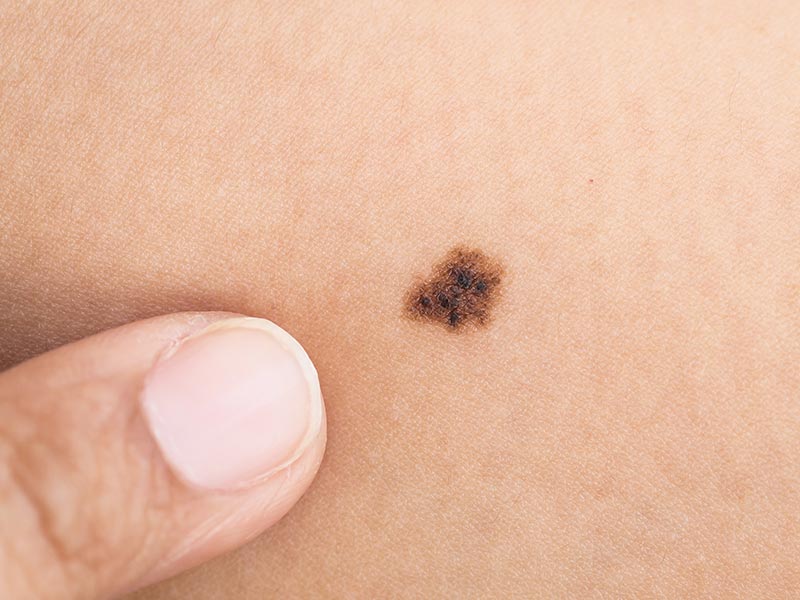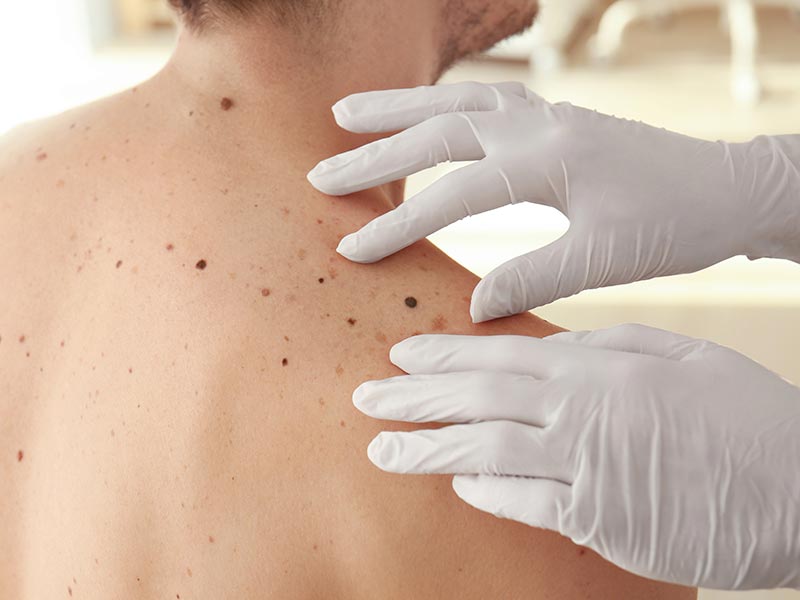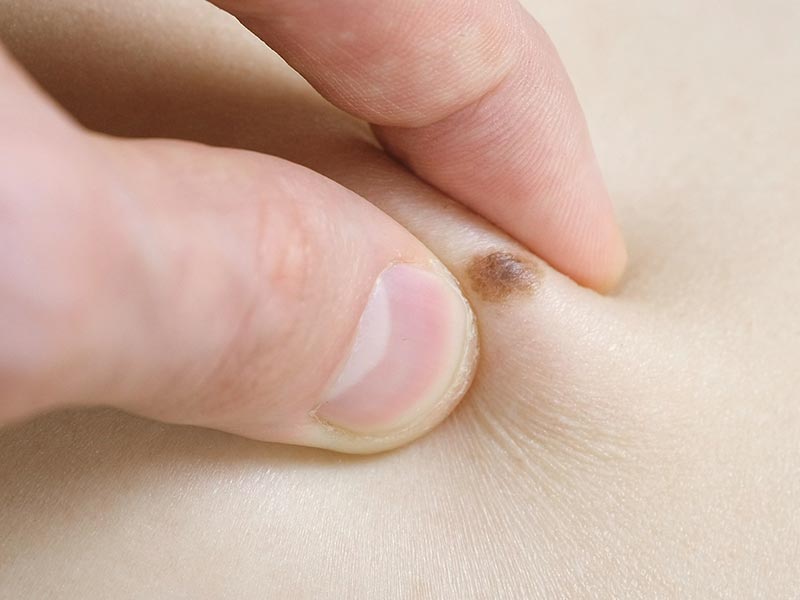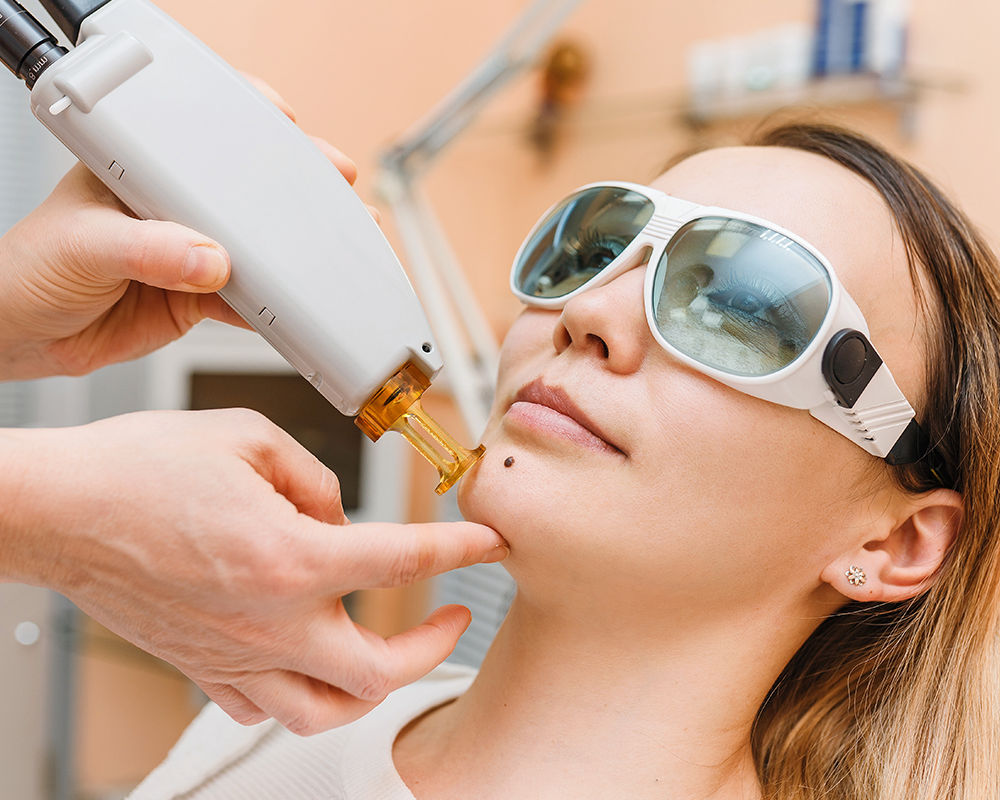Alternative names: Mole, naevus, nevus, junctional naevus, compound naevus, intra-dermal naevus, congenital melanocytic naevus, halo naevus, atypical naevus, dysplastic naevus, birthmark, epidermal naevus, naevus sebaceous, naevus lipomatosus superficialis.
Moles, also known as naevi, are dark spots that can appear anywhere on the body and can be raised or flat. They are made from small aggregates of melanocytes – the cells that provide the pigment in one’s skin. Sometimes moles are present at birth, but usually they develop in childhood. Genetics can play an important role in the likelihood of an individual developing moles. Sun exposure is also a causal factor. Sun damage can trigger changes in a mole that might eventually lead to cancer. It is therefore essential to protect your skin from the sun, especially if you have a lot of moles.
Moles are very common and don’t usually cause any problems. However, you might decide that you want to have a mole removed for cosmetic reasons. Your dermatologist might also recommend mole removal if there is a chance that a mole could be cancerous. Mole removal is a very straightforward procedure that can be performed by your dermatologist at the skin clinic.
REQUEST A CALL BACK
Arrange a consultation with one of our expert dermatologists today.
WHAT DO MOLES LOOK LIKE?
Moles are usually brown but can vary from flesh-coloured, to pink, black or blue. They are sometimes flat (junctional), may be raised and rounded (intradermal) or warty looking (compound). They are usually quite symmetrical, circular and evenly pigmented. If the mole is sitting over a hair follicle then there may be hair growing out of it. The hair in a mole can look thicker or darker than hair on the surrounding skin because it may be carrying extra pigment.
However, moles can sometimes start to change. Changes in the size, shape, colour or symmetry of a mole can be a sign of skin cancer. Moles might also start to itchy, scab over or bleed when they develop into skin cancer. You should check your moles regularly for any signs that they are changing. If you notice anything unusual about a mole then you should see a doctor as it could be a sign of a developing melanoma. Melanoma can be very serious if it is left untreated, so it is important to have any suspicious moles removed and tested. If the mole did contain cancerous cells then your doctor will want to make sure that they were all removed during the procedure.




HOW MIGHT MY MOLES AFFECT ME?
Most moles are not a cause for concern and present a purely cosmetic problem. However, moles can occasional undergo changes that lead to them becoming cancerous i.e. they turn into a malignant melanoma. If a mole is changing in size, shape or colour, it may be coming ‘atypical’ or ‘dysplastic’. Moles that look like this have a higher risk of becoming melanoma, which is why it is essential to have them checked if you have any concern. You should check your own moles regularly for any changes. You can also ask a dermatologist to check your moles for you.
Even if a mole is harmless, it could still have a big impact on your self-esteem and confidence. Raised moles can also be inconvenient if they are in a location where they can easily catch on clothing or jewellery. If you have raised moles in areas where you want to shave or remove hair, then this can also cause problems as there is a risk you could cut or damage the skin. If you’re bothered by a mole in any way then it might be worth considering mole removal. It could make a big difference to how you feel about yourself.
HOW CAN MOLES BE REMOVED?
Mole removal is a simple procedure that can be conducted by a dermatologist at the Harley Street skin clinic in London. You can have a mole removal for cosmetic reasons, but it can sometimes be necessary to remove a mole because there is a risk of skin cancer. Several different types of mole removal can be performed depending on your reasons for having the procedure and the risk of skin cancer.
A cosmetic mole removal can be performed just because you are unhappy with your mole. If you are feeling self-conscious or a raised mole is causing problems by getting caught on your clothing, it might be worth considering a removal. Mole removal can also be required for medical reasons. If you have noticed changes in the size, shape, colour or appearance of a mole, it is a good idea to see a dermatologist at the London clinic. The doctor can assess the risk of skin cancer and perform a removal if necessary.
The two basic techniques that can be used to remove a mole are:
- Shave excision: only the raised portion of a mole is removed, leaving a flat surface that may still contain a darker patch of skin. No stitches are required after this kind of mole removal.
- Surgical excision: the entire mole will be removed, along with a small border of the surrounding skin. The wound will then need to be closed with stitches.
For cosmetic removal, a shave excision is the most satisfactory treatment for getting rid of protuberant moles. If a mole presents worrying signs, surgical excision is the best option: our doctors at The Harley Street Dermatology Clinic offer consultation and treatment services to anyone concerned about their moles and will perform mole removal if necessary or desirable.
Having a mole removed is very easy. Both types of removal are minor procedures that can be carried out by your dermatologist. You will only need to have a local anaesthetic and the procedure can be carried out at the clinic. Depending on the amount of tissue that has to be removed, you may need stitches and there could be a small scar after the procedure. Your doctor can tell you what to expect when you discuss the removal. The removed mole can be checked in the lab for signs of cancer. You may need further treatment if any cancer cells are found. It is vital to ensure that all of the cancer cells have been removed so that the tumour won’t be able to grow back. As long as a border of healthy tissue has been removed all the way around the mole, the chances of the cancer returning are very low.
Remember, if caught and treated early, melanoma can be cured.
For further information on malignant melanoma, please see the British Association of Dermatologists website leaflet on melanoma.
Can a Mole Grow Back After It’s Removed?
If a mole has been removed completely then it will not grow back. After a surgical excision, the tissue will be checked in the lab to ensure that the whole mole has been removed. As long as there is a border of normal tissue all around the mole, there shouldn’t be any cells left behind. This type of removal will be performed if there is a risk of skin cancer as it’s vital to ensure that all the cancerous cells are eliminated.
If any cells are left behind, then the mole can re-appear. Just as the microscopic moles we are born with can develop into visible moles, a few cells left behind after a mole removal can grow into a full-sized mole again. Moles are more likely to grow back if you have a shave excision, as the procedure won’t be attempting to remove the entire mole. You may still be able to see a darker patch after the procedure, as the main purpose is to flatten the mole rather than to get rid of it entirely. The mole can then keep growing and may form a small bump again.
Mole removal is permanent as long as long as you have a surgical excision to remove all of the cells. If there is a risk of skin cancer then it is important to have this type of removal, but if you are getting rid of a mole for cosmetic reasons then you may want to consider a shave excision instead. Even though there is a small chance that the mole could grow back, it can still be the best choice as it’s a simpler procedure with less risk of scarring.
REQUEST A CALL BACK
Please fill in this form and one of our team will give you a call back to arrange a consultation with one of our expert dermatologists.
WHY CHOOSE THE HARLEY STREET DERMATOLGY CLINIC?
Having the right dermatologist is important especially when you have a chronic skin condition that will require ongoing treatment. We want you to feel confident that we’re providing you with the best possible care. We also want you to feel as comfortable as possible with your dermatologist.
The Harley Street Dermatology Clinic specialises in conditions affecting the skin, hair and nails. Our goal is to provide all the care that you need when you’re experiencing these kinds of problems. We want to make it easy for you to access the best quality treatment and support in London.
The clinic is conveniently located in Central London, so it’s easy to visit us if you need to see a dermatologist. You will find yourself in a very comfortable and welcoming environment. We have created a relaxing space where you will receive the highest quality of care. We are regulated by the Care Quality Commission, are part of the British Association of Dermatologists and are top rated by patients of Doctify so you can be sure of safe and effective treatment with us.
CONTACT US
Finding Us
The Harley Street Dermatology Clinic
35 Devonshire Place
London
W1G 6JP
The clinic can be accessed by public transport, on foot or by car. There is paid on street parking around the Harley Street district. The nearest tube stations are Regent’s Park and Baker Street, and Marylebone train station is a 15 minute walk away.
Contact Details
Opening Hours
While appointments can be made available outside usual hours in special circumstances, our core hours are:
Monday: 8am - 6pm
Tuesday: 8am - 6pm
Wednesday: 8am - 6pm
Thursday: 8am - 6pm
Friday: 8am - 6pm
Saturday : 10am - 2pm
Sunday: Closed
FREQUENTLY ASKED QUESTIONS
How should I check my moles for skin cancer?
Checking your moles can take some time, especially if you have a lot of them, so you should start by setting aside some time in a private space. It is best to choose a room with a mirror and plenty of good light as this will help you to see more clearly. You might want to ask someone to help you to check the skin in hard to see areas such as your back or scalp. It can also be helpful to take pictures of your body so that you can track any changes in your moles.
You should carefully check every part of your body for anything unusual. Focus on the moles but remember that different forms of skin cancer can appear anywhere on the body. Don’t ignore any unusual growths or patches that might appear elsewhere. Skin cancer is usually associated with sun damage, so pay particular attention to exposed areas, but remember that it can happen even in less expected places such as the soles of the feet or under the fingernails. If you notice anything that looks suspicious or has changed, then you should consult a doctor just in case it is a sign of skin cancer.
How often do moles need to be checked?
It is important to check moles regularly so that you will be aware of any changes in them. You should also keep an eye out for any new moles that appear in adulthood or other unusual changes in your skin. Performing a mole check on yourself once a month is a good idea, but your dermatologist might also recommend coming in for regular checks if you are at risk of skin cancer. Checking your skin frequently means that any developing skin cancers will be spotted as soon as possible so that they can be removed before they get a chance to cause any serious problems. Melanoma can be very serious or even fatal if it spreads so it is important to ensure it is detected and treated quickly.
What is malignant melanoma?
Melanoma is the form of skin cancer that is most likely to affect moles. It happens when a pigment-producing cell develops an abnormality that enables it to grow into a tumour. Other types of skin cancer can begin in different types of cells and are known as non-melanoma skin cancers. These are less likely to spread than melanoma.
What are the signs of skin cancer in a mole?
Any changes in a mole could be a sign of skin cancer, but you should be particularly aware of moles that grow quickly, become less symmetrical, develop a blurred or irregular border, change colour or start to feel itchy or painful. Moles that scab over or start to bleed could also be signs of skin cancer. If a new mole appears when you are an adult then this can also be a suspicious sign since most moles appear in childhood.
Where can I have a cosmetic mole removal in London?
If you want to arrange a cosmetic mole removal in London then you will need to visit a private skin clinic like the HSDC. You won’t be able to have a cosmetic mole removal on the NHS. You can make an appointment with a private dermatologist directly in order to discuss the options for having a mole removed.
Will there be a scar after I have mole removed?
Mole removal can leave a scar behind, so it is important to discuss this with your doctor before arranging a cosmetic mole removal. The scar will often be less noticeable than the mole, but it can depend on how much skin had to be removed and the part of your body that was affected.
Are there any risks for a mole removal?
Mole removal is a very safe procedure, but there is a small risk of complications such as infection. You may also be left with a scar. Your dermatologist will explain the risks in detail before the procedure and give you advice on caring for the surgical wound in order to reduce the chances of issues such as an infection. If you are having the mole removed for medical reasons then it is important to remember that the risks of removal are much less than the risks of letting a potentially cancerous mole continue to grow.
What causes moles?
Moles are small patches of skin that contain more of the pigment-producing cells known as melanocytes than usual. This makes them appear darker than the surrounding skin. We are usually born with all of our moles, but they are so small that they aren’t usually visible. The moles become apparent as they grow larger during childhood. It is rare for new moles to appear after the age of about 30. If you do notice a new mole as an adult then it should be checked by a dermatologist as there is a chance it could be cancerous.
How common are moles?
Moles are very common. Most people will have between 10 and 40 moles on their bodies, although some people can have a lot more. You are more likely to have moles if you have fair skin. Most people won’t have any problems with their moles, but it is still important to check them regularly. Moles are more likely to develop into skin cancer than other parts of your skin.
